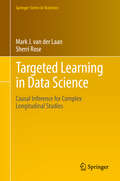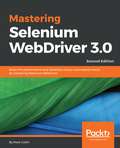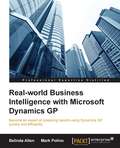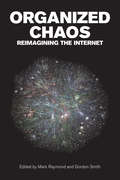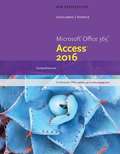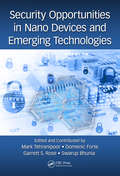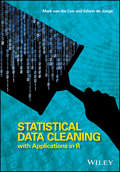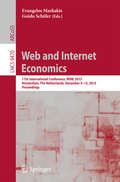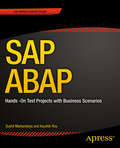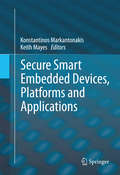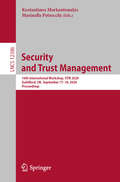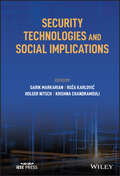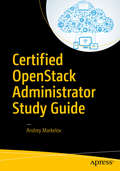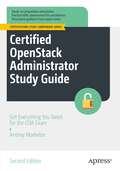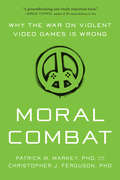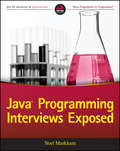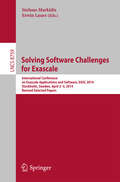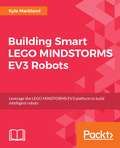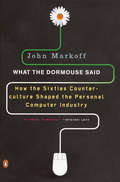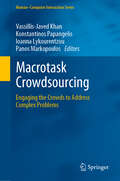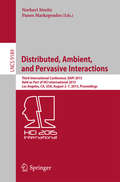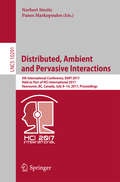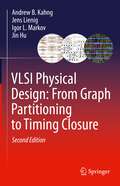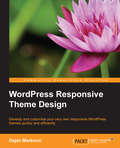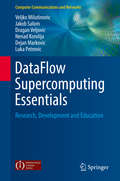- Table View
- List View
Targeted Learning in Data Science: Causal Inference For Complex Longitudinal Studies (Springer Series in Statistics)
by Mark J. van der Laan Sherri RoseThis textbook for graduate students in statistics, data science, and public health deals with the practical challenges that come with big, complex, and dynamic data. It presents a scientific roadmap to translate real-world data science applications into formal statistical estimation problems by using the general template of targeted maximum likelihood estimators. These targeted machine learning algorithms estimate quantities of interest while still providing valid inference. Targeted learning methods within data science area critical component for solving scientific problems in the modern age. The techniques can answer complex questions including optimal rules for assigning treatment based on longitudinal data with time-dependent confounding, as well as other estimands in dependent data structures, such as networks. Included in Targeted Learning in Data Science are demonstrations with soft ware packages and real data sets that present a case that targeted learning is crucial for the next generation of statisticians and data scientists. Th is book is a sequel to the first textbook on machine learning for causal inference, Targeted Learning, published in 2011.Mark van der Laan, PhD, is Jiann-Ping Hsu/Karl E. Peace Professor of Biostatistics and Statistics at UC Berkeley. His research interests include statistical methods in genomics, survival analysis, censored data, machine learning, semiparametric models, causal inference, and targeted learning. Dr. van der Laan received the 2004 Mortimer Spiegelman Award, the 2005 Van Dantzig Award, the 2005 COPSS Snedecor Award, the 2005 COPSS Presidential Award, and has graduated over 40 PhD students in biostatistics and statistics.Sherri Rose, PhD, is Associate Professor of Health Care Policy (Biostatistics) at Harvard Medical School. Her work is centered on developing and integrating innovative statistical approaches to advance human health. Dr. Rose’s methodological research focuses on nonparametric machine learning for causal inference and prediction. She co-leads the Health Policy Data Science Lab and currently serves as an associate editor for the Journal of the American Statistical Association and Biostatistics.
Mastering Selenium WebDriver 3.0: Boost the performance and reliability of your automated checks by mastering Selenium WebDriver, 2nd Edition
by Mark Patrick Leigh CollinComplement Selenium with useful additions that fit seamlessly into the rich and well-crafted API that Selenium offersKey FeaturesUnderstand the power, simplicity, and limitations of the core Selenium frameworkWrite clear, readable, and reliable tests that perform complex test automation tasksWork with ChromeDriver and GeckoDriver in headless modeBook DescriptionThe second edition of Mastering Selenium 3.0 WebDriver starts by showing you how to build your own Selenium framework with Maven. You'll then look at how you can solve the difficult problems that you will undoubtedly come across as you start using Selenium in an enterprise environment and learn how to produce the right feedback when failing. Next, you’ll explore common exceptions that you will come across as you use Selenium, the root causes of these exceptions, and how to fix them. Along the way, you’ll use Advanced User Interactions APIs, running any JavaScript you need through Selenium; and learn how to quickly spin up a Selenium Grid using Docker containers. In the concluding chapters, you‘ll work through a series of scenarios that demonstrate how to extend Selenium to work with external libraries and applications so that you can be sure you are using the right tool for the job.What you will learnProvide fast, useful feedback with screenshotsCreate extensible, well-composed page objectsUtilize ChromeDriver and GeckoDriver in headless modeLeverage the full power of Advanced User Interactions APIsUse JavascriptExecutor to execute JavaScript snippets in the browser through SeleniumBuild user interaction into your test script using JavascriptExecutorLearn the basics of working with AppiumWho this book is forIf you are a software tester or a developer with working experience in Selenium and competency with Java, who is interested in automation and are looking forward to taking the next step in their learning journey, then this is the book for you.
Real-world Business Intelligence with Microsoft Dynamics GP
by Polino Mark Belinda AllenIf you're a GP user, this book is aimed at making your job easier. How? Through the use of Business Intelligence (BI) provided by your Microsoft Dynamics GP software to aid you in making informed decisions. This book assumes no previous experience; however, a basic knowledge of Excel is expected.
Organized Chaos: Reimagining the Internet
by Mark Raymond and Gordon SmithThe Internet is constantly evolving, and has economic, political and social importance as a public good. A coherent strategy for Internet governance is needed to ensure that difficult tradeoffs between competing interests, as well as between distinct public values, are managed in a consistent, transparent and accountable manner that accurately reflects public priorities. In Organized Chaos: Reimagining the Internet, edited by Mark Raymond and Gordon Smith, leading experts address a range of pressing challenges, including cyber security issues and civil society hacktivism by groups such as Anonymous, and consider the international political implications of some of the most likely Internet governance scenarios in the 2015–2020 time frame. Together, the chapters in this volume provide a clear sense of the critical problems facing efforts to update and redefine Internet governance, the appropriate modalities for doing so, and the costs and benefits associated with the most plausible outcomes. This foundation provides the basis for the development of the research-based, high-level strategic vision required to successfully navigate a complex, shifting and uncertain governance environment.
New Perspectives Microsoft Office 365 & Access 2016 Comprehensive
by Mark Shellman; Sasha VodnikAll-new case-based modules, this thorough introduction applies the progressive skills students are learning to real-world situations to ensure that concepts remain highly relevant. A new Productivity Apps module visually introduces Microsoft® One Note, Sway, Office Mix and Edge with fun, hands-on activities.
Security Opportunities in Nano Devices and Emerging Technologies
by Mark Tehranipoor, Domenic Forte, Garrett S. Rose and Swarup BhuniaThe research community lacks both the capability to explain the effectiveness of existing techniques and the metrics to predict the security properties and vulnerabilities of the next generation of nano-devices and systems. This book provides in-depth viewpoints on security issues and explains how nano devices and their unique properties can address the opportunities and challenges of the security community, manufacturers, system integrators, and end users. This book elevates security as a fundamental design parameter, transforming the way new nano-devices are developed. Part 1 focuses on nano devices and building security primitives. Part 2 focuses on emerging technologies and integrations.
Statistical Data Cleaning with Applications in R
by Mark van der Loo Edwin De JongeA comprehensive guide to automated statistical data cleaning <p><p> The production of clean data is a complex and time-consuming process that requires both technical know-how and statistical expertise. Statistical Data Cleaning with Applications in R brings together a wide range of techniques for cleaning textual, numeric or categorical data. This book examines technical data cleaning methods relating to data representation and data structure. A prominent role is given to statistical data validation, data cleaning based on predefined restrictions, and data cleaning strategy.
Web and Internet Economics: 11th International Conference, WINE 2015, Amsterdam, The Netherlands, December 9-12, 2015, Proceedings (Lecture Notes in Computer Science #9470)
by Evangelos Markakis Guido SchäferThis book constitutes the thoroughly refereed proceedings of the 11th International Conference on Web and Internet Economics, WINE 2015, held in Amsterdam, The Netherlands, in December 2015. The 30 regular papers presented together with 8 abstracts were carefully reviewed and selected from 142 submissions and cover results on incentives and computation in theoretical computer science, artificial intelligence, and microeconomics.
Sap Abap
by Sushil Markandeya Kaushik RoySAP ABAP (Advanced Business Application Programming) offers a detailed tutorial on the numerous features of the core programming platform, used for development for the entire SAP software suite. SAP ABAP uses hands on business oriented use cases and a valuable dedicated e-resource to demonstrate the underlying advanced concepts of the OO ABAP environment and the SAP UI. SAP ABAP covers the latest version (NetWeaver 7. 3 and SAP application programming release 6. 0) of the platform for demonstrating the customization and implementation phases of the SAP software implementation. Void of theoretical treatments and preoccupation with language syntax, SAP ABAP is a comprehensive, practical one stop solution,which demonstrates and conveys the language's commands and features through hands on examples. The accompanying e-resource is a take off point to the book. SAP ABAP works in tandem with the accompanying e-resource to create an interactive learning environment where the book provides a brief description and an overview of a specified feature/command, showing and discussing the corresponding code. At the reader's option, the user can utilize the accompanying e-resource, where a step-by-step guide to creating and running the feature's object is available. The presentation of the features is scenario oriented, i. e. most of the features are demonstrated in terms of small business scenarios. The e-resource contains the scenario descriptions, screen shots, detailed screen cams and ABAP program source to enable the reader to create all objects related to the scenario and run/execute them. The underlying concepts of a feature/command are conveyed through execution of these hands-on programs. Further exercises to be performed independently by the reader are also proposed. The demonstration/illustration objects including the programs rely on some of the SAP application tables being populated, for example an IDES system which is now a de facto system for all SAP training related activities. What you'll learn The core ABAP platform Advanced concepts of OO programming with ABAP SAP application tables IDES system Programming the SAP user interface Who this book is for For beginners in SAP application programming, and as a reference for practicing professionals and consultants in SAP ABAP. Table of Contents 1. ERP and SAP Overview 2. ABAP Dictionary/Data Dictionary/Dictionary/DDIC I 3. ABAP Dictionary/Data Dictionary/Dictionary/DDIC II 4. ABAP Language Basics 5. Write Statement (Classical Reporting) 6. Internal Tables 7. Modularization 8. Open SQL Data Retrieval 9. SELECTION-SCREEN 10. Interactive Lists 11. ABAP OOPS 12. ALV (ABAP List Viewer) Outputs I 13. ALV (ABAP List Viewer) Outputs II 14. Screen Programming 15. Appendix
Secure Smart Embedded Devices, Platforms and Applications
by Konstantinos Markantonakis Keith MayesNew generations of IT users are increasingly abstracted from the underlying devices and platforms that provide and safeguard their services. As a result they may have little awareness that they are critically dependent on the embedded security devices that are becoming pervasive in daily modern life. Secure Smart Embedded Devices, Platforms and Applications provides a broad overview of the many security and practical issues of embedded devices, tokens, and their operation systems, platforms and main applications. It also addresses a diverse range of industry/government initiatives and considerations, while focusing strongly on technical and practical security issues. The benefits and pitfalls of developing and deploying applications that rely on embedded systems and their security functionality are presented. A sufficient level of technical detail to support embedded systems is provided throughout the text, although the book is quite readable for those seeking awareness through an initial overview of the topics. This edited volume benefits from the contributions of industry and academic experts and helps provide a cross-discipline overview of the security and practical issues for embedded systems, tokens, and platforms. It is an ideal complement to the earlier work, Smart Cards Tokens, Security and Applications from the same editors.
Security and Trust Management: 16th International Workshop, STM 2020, Guildford, UK, September 17–18, 2020, Proceedings (Lecture Notes in Computer Science #12386)
by Kostantinos Markantonakis Marinella PetrocchiThis book constitutes the proceedings of the 16th International Workshop on Security and Trust Management, STM 2020, co-located with the 25th European Symposium on Research in Computer Security, ESORICS 2020. The conference was planned to take place in Guildford, UK, but had to be moved to an online format due to the COVID-19 pandemic. The workshop took place during September 17-18, 2020. The 8 papers presented in this volume were carefully reviewed and selected from 20 submissions. They were organized in topical sections on security properties and attacks; confidentiality schema and security processes.
Security Technologies and Social Implications
by Garik Markarian Ru A Karlovi Holger Nitsch Krishna ChandramouliB>SECURITY TECHNOLOGIES AND SOCIAL IMPLICATIONS Explains how the latest technologies can advance policing and security, identify threats, and defend citizens from crime and terrorism Security Technologies and Social Implications focuses on the development and application of new technologies that police and homeland security officers can leverage as a tool for both predictive and intelligence-led investigations. The book recommends the best practices for incorporation of these technologies into day-to-day activities by law enforcement agencies and counter-terrorism units. Practically, it addresses legal, technological, and organizational challenges (e.g. resource limitation and privacy concerns) combined with challenges related to the adoption of innovative technologies. In contrast to classic tools, modern policing and security requires the development and implementation of new technologies using AI, machine learning, social media tracking, drones, robots, GIS, computer vision, and more. As crime (and cybercrime in particular) becomes more and more sophisticated, security requires a complex mix of social measures, including prevention, detection, investigation, and prosecution. Key topics related to these developments and their implementations covered in Security Technologies and Social Implications include: New security technologies and how these technologies can be implemented in practice, plus associated social, ethical or policy issues Expertise and commentary from individuals developing and testing new technologies and individuals using the technologies within their everyday roles The latest advancements in commercial and professional law enforcement technologies and platforms Commentary on how technologies can advance humanity by making policing and security more efficient and keeping citizens safe Security Technologies and Social Implications serves as a comprehensive resource for defense personnel and law enforcement staff, practical security engineers, and trainee staff in security and police colleges to understand the latest security technologies, with a critical look at their uses and limitations regarding potential ethical, regulatory, or legal issues.
Certified OpenStack Administrator Study Guide
by Andrey MarkelovTeaches you how and what to study in order to be best prepared for the Certified OpenStack Administrator exam. This fast-growing technology is creating a market that needs more qualified IT specialists with proven skills. This book covers 100% of the exam requirements for both The OpenStack Foundation and the Mirantis OpenStack Certification Exam.Each theme is taught using practical exercises and instructions for the command line and for the graphical client (Horizon). Each chapter is followed by review questions, complete with answers. Even after you have taken and passed your OpenStack exam, this book will remain a useful reference. What You Will LearnUnderstand the components that make up the cloud.Install and make an OpenStack distribution from Mirantis, Red Hat or another community version.Work with OpenStack Identity Management, Dashboard, CLI, Object Storage, Block Storage, Networking, Telemetry, Orchestration, and Image Services.Learn how to troubleshoot all the main OpenStack services.Understand where to find information for future work with OpenStack.Who This Book Is ForCertified OpenStack Administrator Study Guide is for Cloud and Linux engineers looking for a better understanding of how to work with the modern OpenStack IaaS Cloud, and wants to prove their knowledge by passing a Certified OpenStack Administrator Exam.
Certified OpenStack Administrator Study Guide: Get Everything You Need for the COA Exam (Certification Study Companion Series)
by Andrey MarkelovGain a better understanding of how to work with the modern OpenStack IaaS Cloud platform. This updated book is designed to help you pass the latest “Yoga” version of the Certified OpenStack Administrator (COA) exam from the Open Infrastructure Foundation. OpenStack is a cloud operating system that controls large pools of computer storage and networking resources throughout a datacenter.All exercises have been updated and re-written for the current version of the exam using the modern CLI tool. This book covers 100% of the exam requirements and each topic is taught using practical exercises and instructions for the command line and for the Horizon dashboard. All chapters are followed by review questions and answers. Even after you have taken and passed the COA exam, this book will remain a useful reference to come back to time after time.What You Will LearnUnderstand the components that make up the CloudInstall OpenStack distribution from Red Hat, Canonical or community versionsRun OpenStack in a virtual test environmentUnderstand where to find information for to further work with OpenStackWho This Book Is ForCloud and Linux engineers who want to pass the Certified OpenStack Administrator Exam.
Moral Combat: Why the War on Violent Video Games Is Wrong
by Patrick M. Markey Christopher J. FergusonIn family rooms across America, millions of children and teenagers are playing video games, such as Call of Duty, Halo, and Grand Theft Auto, roaming violent virtual worlds-with virtual guns in their hands.In what sometimes seems like an increasingly violent world, it's only natural to worry about the effects of all this pixelated gore. But is that concern misplaced? Authors and psychologists Patrick M. Markey and Christopher J. Ferguson say it is.The media and politicians have been sounding the alarm for years, and with every fresh tragedy involving a young perpetrator comes another flurry of articles about the dangers of violent media. The problem is this: Their fear isn't supported by the evidence. In fact, unlike the video game-trained murder machines depicted in the press, school shooters are actually less likely to be interested in violent games than their peers. In reality, most well-adjusted children and teenagers play violent video games, all without ever exhibiting violent behavior in real life. What's more, spikes in sales of violent games actually correspond to decreased rates of violent crime.If that surprises you, you're not alone-the national dialogue on games and violence has been hopelessly biased. But that's beginning to change. Scholars are finding that not only are violent games not one of society's great evils, they may even be a force for good.In Moral Combat, Markey and Ferguson explore how video games-even the bloodiest-can have a positive impact on everything from social skills to stress, and may even make us more morally sensitive. Tracing the rise of violent games from arcades to online deathmatches, they have spent years on the front lines of the video game debate and now offer a comprehensive overview of the scientific research on gaming. With humor, complete honesty, and extensive research, they separate the myth from the medium.Moral Combat is an irreverent and informative guide to the worries-and wonders-of our violent virtual world.
Java Programming Interviews Exposed
by Noel MarkhamIf you are a skilled Java programmer but are concerned about the Java coding interview process, this real-world guide can help you land your next positionJava is a popular and powerful language that is a virtual requirement for businesses making use of IT in their daily operations. For Java programmers, this reality offers job security and a wealth of employment opportunities. But that perfect Java coding job won't be available if you can't ace the interview. If you are a Java programmer concerned about interviewing, Java Programming Interviews Exposed is a great resource to prepare for your next opportunity. Author Noel Markham is both an experienced Java developer and interviewer, and has loaded his book with real examples from interviews he has conducted.Review over 150 real-world Java interview questions you are likely to encounterPrepare for personality-based interviews as well as highly technical interviewsExplore related topics, such as middleware frameworks and server technologiesMake use of chapters individually for topic-specific help Use the appendix for tips on Scala and Groovy, two other languages that run on JVMsVeterans of the IT employment space know that interviewing for a Java programming position isn't as simple as sitting down and answering questions. The technical coding portion of the interview can be akin to a difficult puzzle or an interrogation. With Java Programming Interviews Exposed, skilled Java coders can prepare themselves for this daunting process and better arm themselves with the knowledge and interviewing skills necessary to succeed.
Solving Software Challenges for Exascale
by Stefano Markidis Erwin LaureThis volume contains the thoroughly refereed post-conference proceedings of the Second International Conference on Exascale Applications and Software, EASC 2014, held in Stockholm, Sweden, in April 2014. The 6 full papers presented together with 6 short papers were carefully reviewed and selected from 17 submissions. They are organized in two topical sections named: toward exascale scientific applications and development environment for exascale applications.
Building Smart LEGO MINDSTORMS EV3 Robots: Leverage the LEGO MINDSTORMS EV3 platform to build and program intelligent robots
by Kyle MarklandBuild and program smart robots with the EV3.Key FeaturesEfficiently build smart robots with the LEGO MINDSTORMS EV3Discover building techniques and programming concepts that are used by engineers to prototype robots in the real world This project-based guide will teach you how to build exciting projects such as the objecta-tracking tank, ultimate all-terrain vehicle, remote control race car, or even a GPS-navigating autonomous vehicle Book DescriptionSmart robots are an ever-increasing part of our daily lives. With LEGO MINDSTORMS EV3, you can now prototype your very own small-scale smart robot that uses specialized programming and hardware to complete a mission. EV3 is a robotics platform for enthusiasts of all ages and experience levels that makes prototyping robots accessible to all.This book will walk you through six different projects that range from intermediate to advanced level. The projects will show you building and programming techniques that are used by engineers in the real world, which will help you build your own smart robot.You'll see how to make the most of the EV3 robotics platform and build some awesome smart robots. The book starts by introducing some real-world examples of smart robots. Then, we'll walk you through six different projects and explain the features that allow these robots to make intelligent decisions. The book will guide you as you build your own object-tracking tank, a box-climbing robot, an interactive robotic shark, a quirky bipedal robot, a speedy remote control race car, and a GPS-navigating robot.By the end of this book, you'll have the skills necessary to build and program your own smart robots with EV3.What you will learn Understand the characteristics that make a robot smart Grasp proportional beacon following and use proximity sensors to track an objectDiscover how mechanisms such as rack-and-pinion and the worm gear work Program a custom GUI to make a robot more user friendly Make a fun and quirky interactive robot that has its own personality Get to know the principles of remote control and programming car-style steering Understand some of the mechanisms that enable a car to drive Navigate to a destination with a GPS receiverWho this book is forThis book is for hobbyists, robotic engineers, and programmers who understand the basics of the EV3 programming language and are familiar with building with LEGO Technic and want to try some advanced projects. If you want to learn some new engineering techniques and take your experience with the EV3 to the next level, then this book is for you.
What the Dormouse Said: How the Sixties Counterculture Shaped the Personal ComputerIndustry
by John MarkoffMost histories of the personal computer industry focus on technology or business. John Markoff's landmark book is about the culture and consciousness behind the first PCs--the culture being counter- and the consciousness expanded, sometimes chemically. It's a brilliant evocation of Stanford, California, in the 1960s and '70s, where a group of visionaries set out to turn computers into a means for freeing minds and information. In these pages one encounters Ken Kesey and the phone hacker Cap'n Crunch, est and LSD, The Whole Earth Catalog and the Homebrew Computer Lab. What the Dormouse Said is a poignant, funny, and inspiring book by one of the smartest technology writers around.
Macrotask Crowdsourcing: Engaging the Crowds to Address Complex Problems (Human–Computer Interaction Series)
by Panos Markopoulos Vassillis-Javed Khan Konstantinos Papangelis Ioanna LykourentzouCrowdsourcing is an emerging paradigm that promises to transform several domains: creative work, business work, cultural cooperation, etc. Crowdsourcing reflects the close-knit interplay between the latest computer technologies, the rapidly changing work model of the 21st century, and the very nature of people. The interplay makes for an exciting but at the same time challenging new field to investigate under the lens of a diverse set of disciplines, ranging from the technical to the social and from the theoretical to the applied. Early research has focused on an aspect of crowdsourcing known as micro-tasking. Micro-tasks are simple tasks (like image annotations) that anyone could perform. An emerging area is how to utilize crowdsourcing to solve problems that go beyond simple tasks towards more complex ones, that require collaboration and creativity. In juxtaposition to micro-task crowdsourcing, this book investigates macro-task crowdsourcing and its potential.
Distributed, Ambient and Pervasive Interactions
by Panos Markopoulos Norbert StreitzThis book constitutes the refereed proceedings of the 5th International Conference on Distributed, Ambient and Pervasive Interactions, DAPI 2013, held as part of the 15th International Conference on Human-Computer Interaction, HCII 2013, held in Las Vegas, USA in July 2013, jointly with 12 other thematically similar conferences. The total of 1666 papers and 303 posters presented at the HCII 2013 conferences was carefully reviewed and selected from 5210 submissions. These papers address the latest research and development efforts and highlight the human aspects of design and use of computing systems. The papers accepted for presentation thoroughly cover the entire field of human-computer interaction, addressing major advances in knowledge and effective use of computers in a variety of application areas. The total of 54 contributions was carefully reviewed and selected for inclusion in the DAPI proceedings. The papers are organized in the following topical sections: natural interaction; context-awareness in smart and intelligent environments; design and evaluation of smart and intelligent environments; smart cities; multi-user, group and collaborative interaction; smart everyday living and working environments.
Distributed, Ambient and Pervasive Interactions: 5th International Conference, DAPI 2017, Held as Part of HCI International 2017, Vancouver, BC, Canada, July 9–14, 2017, Proceedings (Lecture Notes in Computer Science #10291)
by Panos Markopoulos Norbert StreitzThis book constitutes the refereed proceedings of the 5th International Conference on Distributed, Ambient and Pervasive Interactions, DAPI 2013, held as part of the 15th International Conference on Human-Computer Interaction, HCII 2013, held in Las Vegas, USA in July 2013, jointly with 12 other thematically similar conferences. The total of 1666 papers and 303 posters presented at the HCII 2013 conferences was carefully reviewed and selected from 5210 submissions. These papers address the latest research and development efforts and highlight the human aspects of design and use of computing systems. The papers accepted for presentation thoroughly cover the entire field of human-computer interaction, addressing major advances in knowledge and effective use of computers in a variety of application areas. The total of 54 contributions was carefully reviewed and selected for inclusion in the DAPI proceedings. The papers are organized in the following topical sections: natural interaction; context-awareness in smart and intelligent environments; design and evaluation of smart and intelligent environments; smart cities; multi-user, group and collaborative interaction; smart everyday living and working environments.
VLSI Physical Design: From Graph Partitioning to Timing Closure
by Igor L. Markov Andrew B. Kahng Jens Lienig Jin HuThe complexity of modern chip design requires extensive use of specialized software throughout the process. To achieve the best results, a user of this software needs a high-level understanding of the underlying mathematical models and algorithms. In addition, a developer of such software must have a keen understanding of relevant computer science aspects, including algorithmic performance bottlenecks and how various algorithms operate and interact. This book introduces and compares the fundamental algorithms that are used during the IC physical design phase, wherein a geometric chip layout is produced starting from an abstract circuit design. This updated second edition includes recent advancements in the state-of-the-art of physical design, and builds upon foundational coverage of essential and fundamental techniques. Numerous examples and tasks with solutions increase the clarity of presentation and facilitate deeper understanding. A comprehensive set of slides is available on the Internet for each chapter, simplifying use of the book in instructional settings.“This improved, second edition of the book will continue to serve the EDA and design community well. It is a foundational text and reference for the next generation of professionals who will be called on to continue the advancement of our chip design tools and design the most advanced micro-electronics.” Dr. Leon Stok, Vice President, Electronic Design Automation, IBM Systems Group“This is the book I wish I had when I taught EDA in the past, and the one I’m using from now on.” Dr. Louis K. Scheffer, Howard Hughes Medical Institute“I would happily use this book when teaching Physical Design. I know of no other work that’s as comprehensive and up-to-date, with algorithmic focus and clear pseudocode for the key algorithms. The book is beautifully designed!”Prof. John P. Hayes, University of Michigan“The entire field of electronic design automation owes the authors a great debt for providing a single coherent source on physical design that is clear and tutorial in nature, while providing details on key state-of-the-art topics such as timing closure.”Prof. Kurt Keutzer, University of California, Berkeley“An excellent balance of the basics and more advanced concepts, presented by top experts in the field.” Prof. Sachin Sapatnekar, University of Minnesota
WordPress Responsive Theme Design
by Dejan MarkovicIf you are a WordPress enthusiast who wants to develop and customize your own responsive WordPress theme, this book is for you. Some experience with WordPress, HTML, PHP, and CSS is expected and highly recommended.
DataFlow Supercomputing Essentials: Research, Development and Education (Computer Communications and Networks)
by Dejan Markovic Jakob Salom Veljko Milutinovic Dragan Veljovic Nenad Korolija Luka PetrovicThis informative text/reference highlights the potential of DataFlow computing in research requiring high speeds, low power requirements, and high precision, while also benefiting from a reduction in the size of the equipment. The cutting-edge research and implementation case studies provided in this book will help the reader to develop their practical understanding of the advantages and unique features of this methodology. This work serves as a companion title to DataFlow Supercomputing Essentials: Algorithms, Applications and Implementations, which reviews the key algorithms in this area, and provides useful examples. Topics and features: reviews the library of tools, applications, and source code available to support DataFlow programming; discusses the enhancements to DataFlow computing yielded by small hardware changes, different compilation techniques, debugging, and optimizing tools; examines when a DataFlow architecture is best applied, and for which types of calculation; describes how converting applications to a DataFlow representation can result in an acceleration in performance, while reducing the power consumption; explains how to implement a DataFlow application on Maxeler hardware architecture, with links to a video tutorial series available online. This enlightening volume will be of great interest to all researchers investigating supercomputing in general, and DataFlow computing in particular. Advanced undergraduate and graduate students involved in courses on Data Mining, Microprocessor Systems, and VLSI Systems, will also find the book to be a helpful reference.
